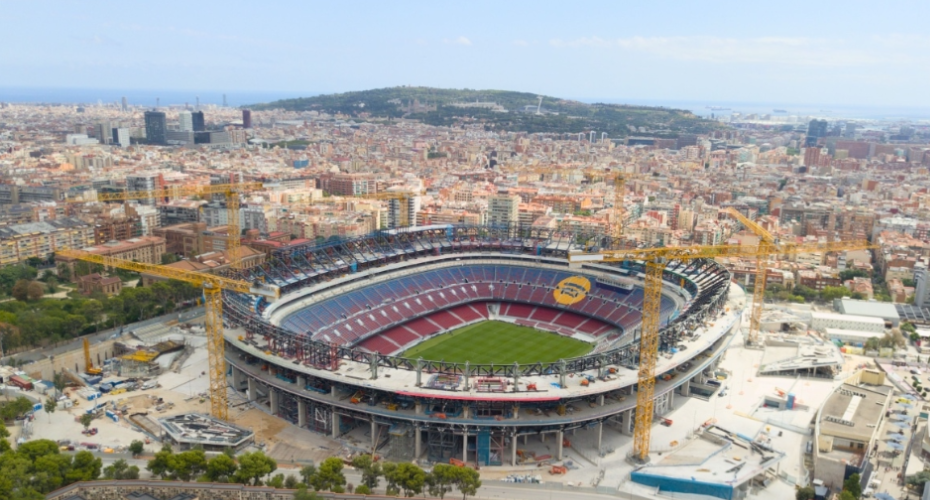Barcelona are now almost a year behind schedule on their original plan to return to the Camp Nou and there is still no confirmed date for when supporters will finally be back inside. When work began on the €1.5 billion refurbishment in June 2023 the club promised that the ground would re-open in time for their 125th anniversary in November 2024 at a reduced capacity while work continued. That target has been moved several times and the delays are causing growing frustration.
Before each of their three home fixtures so far this season Barcelona had suggested the matches would be staged at the Camp Nou, only to issue last-minute announcements confirming they would be played elsewhere. Two La Liga matches have already taken place at the 6,000-capacity Estadi Johan Cruyff next to the training ground and this Sunday Real Sociedad will be hosted at the Estadi Olímpic Lluís Companys where Barca have already spent two seasons. The decision to use Montjuic was only confirmed on Tuesday evening despite Barcelona having invited journalists to tour the Camp Nou that morning while calling on local authorities to issue the permits needed to open the ground.
“Just because the stadium isn’t finished doesn’t mean it isn’t safe,” said vice-president Elena Fort. “The Spotify Camp Nou is the safest stadium in all of Spain. You can play in the stadium. The club’s wish is for the city council to issue the First Occupancy Certificate for Sunday’s match. All the documentation has been submitted so that this can be issued.”
A few hours later the city council responded with a press briefing of their own and their message could not have been more different. Journalists who had been inside the stadium earlier in the day noticed that fan entrances had not been shown and the visiting team’s dressing rooms were clearly incomplete, even though Fort maintained they were usable if not yet visually pleasing. Fort added that “Now it only depends on the city council. We have presented all the legally required documentation with all the deficiencies corrected. Barca have the obligation to ask for the Camp Nou to be reopened. We expect maximum complicity. Today we should have received the First Occupancy License and here we are.”
Inside the Camp Nou there was a sense of how impressive the finished stadium will be. On a sunny day with announcements playing over the loudspeakers simulating line-ups, you could imagine matches taking place there soon. The ground felt brighter and more modern, the lower stands looked transformed and the pitch was in immaculate condition. The gloom that often clung to certain corners of the old Camp Nou has given way to something more open and renewed, even if some areas remain unfinished.
The city council’s own stance was clear. They stressed that safety was the priority and that their processes would not be rushed. Deputy mayor Laia Bonet said “We share the same will with the club, which is for Barca to return to the stadium as soon as possible. But the city council needs to guarantee the safety of every fan. This is our priority. We have to make sure all the professionals and technicians can work as rigorously as possible.” Sebastia Massague, director of civil protection, added “We have spotted different elements that need to be fixed and that have an impact on the safety and security of the stadium. When all those issues are fixed and resolved, the city council would have to check and validate it, to finally grant the partial occupational license to host 27,000 people.” He confirmed that no test event would be required before Barcelona invited fans back to the ground.
The reality is that nobody knows exactly when Barcelona will return to the Camp Nou. The council gave no timeframe and stressed that the decision depends entirely on the club resolving the highlighted issues. For now, only the next two home fixtures have confirmed venues. Real Sociedad in La Liga will be played at Montjuic on Sunday, and Paris Saint-Germain will visit the same stadium in the Champions League on October 1. The following home match against Girona on October 18 remains technically possible at the Camp Nou but the council repeated that the deciding factor will be whether their safety concerns have been addressed.
The players themselves appear relatively unfazed. Sources close to the squad admitted the situation is absurd for a club of Barcelona’s stature but stressed that the team is ready to perform wherever required. They also expressed genuine excitement about returning to the Camp Nou, eager to step out again in front of their fans in the revamped stadium.
The chaos is damaging in many ways. With calmer long-term planning the situation could have been avoided by deciding in the summer to delay the reopening for at least six more months. That would have given time for construction to progress and for fans and staff to have certainty. Deputy mayor Albert Batlle had publicly called for exactly that in mid-August. Instead Barcelona’s leadership under Joan Laporta has been defined by short-term decisions and improvisation. The financial “levers” policy is the most glaring example, raising quick funds for transfers without solving the deeper structural problems.
Laporta insists that returning to the Camp Nou is vital for the club’s fragile finances. Once complete the stadium will hold 105,000 and generate record revenue. Back in 2023 the club estimated that one season at Montjuic would cost €90 million in lost matchday income. Now that two seasons have already passed away from home, the losses could be closer to €180 million, especially with attendances at Montjuic proving underwhelming at times.
For football fans planning an away day in Barcelona the story adds unpredictability to every trip. The Camp Nou is still the ultimate destination, an icon of world football that will look even more spectacular when complete. Until then supporters need to be ready for the unexpected, whether it means heading to Montjuic or even the intimate Estadi Johan Cruyff. But when the gates of the new Camp Nou finally open the atmosphere will be unmissable, a pilgrimage for travelling supporters and one of the defining football experiences in Europe.









